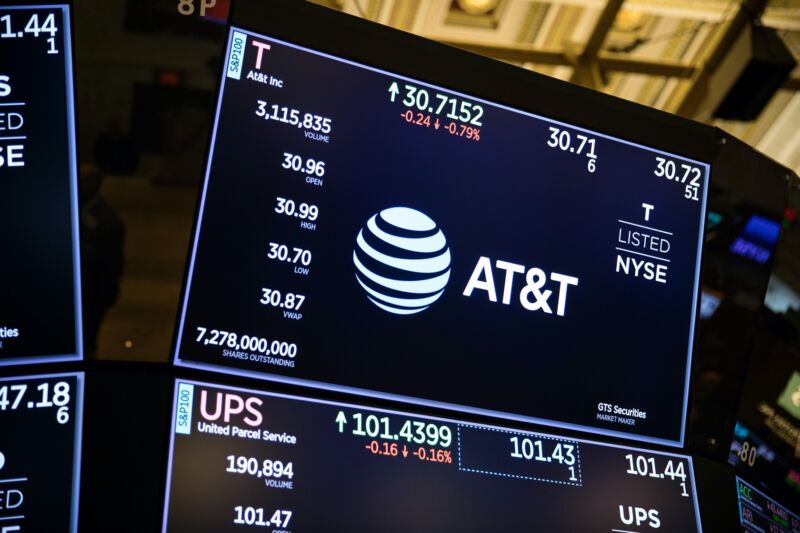 reader comments
reader comments
89 with 76 posters participating
AT&T today announced it will spin off WarnerMedia—including HBO and Warner Bros.—into a new company, less than three years after AT&T bought Time Warner Inc. for $108 billion.
AT&T said it struck a deal with Discovery, Inc. to combine WarnerMedia and Discovery’s assets into a “standalone global entertainment company.” AT&T would receive $43 billion in the all-stock transaction through “a combination of cash, debt securities, and WarnerMedia’s retention of certain debt.” AT&T shareholders would receive stock in 71 percent of the new media company, while Discovery shareholders would own the other 29 percent.
AT&T expects it to take a full year to complete the spinoff and combination with Discovery. “The transaction is anticipated to close in mid-2022, subject to approval by Discovery shareholders and customary closing conditions, including receipt of regulatory approvals,” AT&T said.
AT&T says it will shift its own focus back to broadband.
“For AT&T shareholders, this is an opportunity to unlock value and be one of the best capitalized broadband companies, focused on investing in 5G and fiber to meet substantial, long-term demand for connectivity,” AT&T CEO John Stankey said. “AT&T shareholders will retain their stake in our leading communications company that comes with an attractive dividend. Plus, they will get a stake in the new company, a global media leader that can build one of the top streaming platforms in the world.”
The as-yet-unnamed WarnerMedia/Discovery company will consist of over 100 brands, including “HBO, Warner Bros., Discovery, DC Comics, CNN, Cartoon Network, HGTV, Food Network, the Turner Networks, TNT, TBS, Eurosport, Magnolia, TLC, Animal Planet, ID and many more,” AT&T said.
Verizon said it agreed to sell Yahoo and AOL for $5 billion to private-equity firm Apollo Global Management. The telecom giants’ bets on the media business haven’t paid off as they hoped, but AT&T’s investment in media was much bigger than Verizon’s.
Today’s announcement “is an admission that putting a large content asset with a wireless phone company had few long-lasting synergies,” CNBC wrote. “If anything, WarnerMedia became an albatross on AT&T shares, which have underperformed Verizon and T-Mobile since the deal’s completion date on June 14, 2018.”
AT&T’s Time Warner and DirecTV acquisitions were both made under Stankey’s predecessor as CEO, Randall Stephenson.
Massive layoffs after AT&T/Time Warner merger
AT&T eliminated about 45,000 jobs across its media and telecom divisions after buying Time Warner. AT&T had 273,210 employees immediately after buying Time Warner in mid-2018 and just 228,470 as of March 31, 2021.
Stephenson had claimed that AT&T would create “7,000 jobs of people putting fiber in [the] ground” in exchange for a big corporate tax cut. AT&T continued laying employees off instead, hurting its ability to expand its fiber network and maintain its legacy copper network. A report commissioned by the California state government found that AT&T let its copper phone network deteriorate through neglect, especially in low-income communities and areas without substantial competition, despite raising its phone prices by 152.6 percent over 12 years.
With AT&T retaining its core telecom business, the company said the deal “results in two independent companies—one broadband connectivity and the other media—to sharpen the investment focus and attract the best investor base for each company.” With $43 billion coming back to AT&T, the telco said it will be “one of the best capitalized 5G and fiber broadband companies in the United States.”
announced a deal to sell a minority stake in DirecTV and spin it out into a new subsidiary. In that case, AT&T will own 70 percent of the spun-off DirecTV company.
AT&T plans more fiber expansion
After offloading WarnerMedia in mid-2022, AT&T said it plans “increased capital investment for incremental investments in 5G and fiber broadband,” with annual capital expenditures of around $24 billion. AT&T slashed capital expenditures the last couple years; after spending $21.25 billion in 2018, AT&T spent $19.64 billion in 2019 and $15.68 billion in 2020. AT&T recently said it plans $17 billion in capital expenditures in 2021.
“AT&T expects its 5G C-band network will cover 200 million people in the US by year-end 2023,” and “the company plans to expand its fiber footprint to cover 30 million customer locations by year-end 2025,” AT&T said today. Those 30 million locations would include both homes and businesses.
In March, AT&T said it “plans to increase its fiber footprint by an additional 3 million customer locations” in 2021. There are tens of millions of homes lacking fiber access in AT&T’s 21-state wireline territory. In October 2020, the Communications Workers of America union told us that 14.93 million out of 52.97 million households in AT&T’s home-Internet service area had fiber-to-the-home access. AT&T has ignored rural areas in its previous fiber buildouts, and the 3 million new locations this year are all planned for metro areas.






